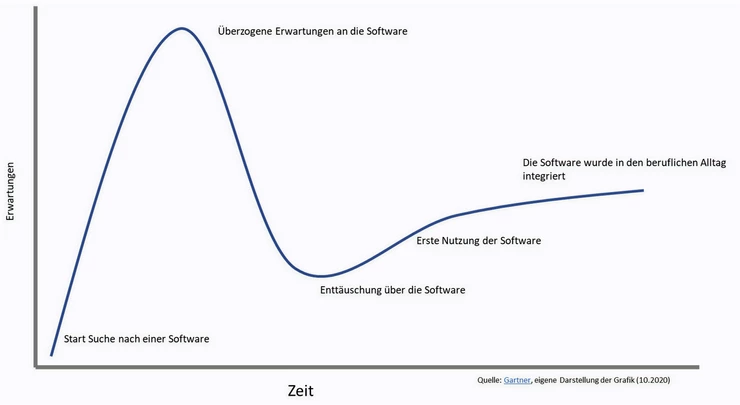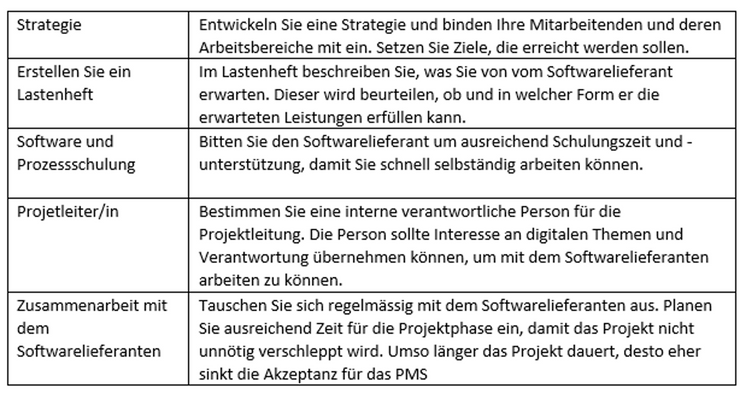How easy is it to integrate portfolio management systems (PMS)? Well, according to experience, asset managers in particular underestimate the actual effort required for such an implementation. In the end, a PMS always means a change, regardless of whether one was already in place or not.
In this article, we will go into more detail about the false requirements of a PMS and what you need to be prepared for if you want to integrate a PMS into your company. In particular, we will look at the Gartner Hype Cycle Model which describes the process very well and which you can also use to prepare for a PMS implementation.
Decision for a PMS system
First of all, however, you have to decide on a PMS system. But how important is this decision in the further course? Well, first of all, you have to consider that you are not just buying a simple system that will be integrated into your company and your daily work.
You also choose a company that installs the PMS in your business and provides the technical know-how for the implementation, at least in most cases. Therefore, you should take a close look at the company and its services.
An important point when deciding on a PMS provider is the customer service. The software provider you finally choose should offer competent and reliable customer service. This ensures that you will receive support when problems arise.
The 5 phases of expectation
Many asset managers think that such software simply has to be installed, the client data imported and everything works smoothly. In fact, however, there is much more to it than that. Now you can find out which hurdles you will face and how you can avoid them. To do this, we take Gartner's Hype Cycle, which basically describes the various reactions of the general public to new technologies. However, the cycle can also be described analogously for expectations of portfolio management software.

Stage 1: Start searching for a software
You are facing the decision to invest in a PMS for the first time or you are looking to change your current software solution.
In the first phase, you will first research and compare the different providers. You will choose a provider whose PMS fits you and your initial expectations exactly.
Step 2: Excessive expectations of the software
In fact, however, most asset managers have too high and individual expectations of a PMS, which not every one can fulfil to this extent.
A PMS is not simply buying, installing software and connecting to the banking interface, but there is much more to it.
These exaggerated expectations offer a high potential for disappointment!
Step 3: Disappointment with the software
In the next step you will experience a "valley of disappointment". Because after the overly high expectations have not been fulfilled, you find yourself with a PMS that does not fit 100% into your company. The reasons for this vary. Work with the software supplier to align your processes and the PMS.
Step 4: First use of the software
If you are not happy with your PMS and notice that something is wrong, it's time to make a change. Of course, it goes without saying that this process will be a little slower. After all, old structures have to be broken up. The employees have to be trained for new processes and finally they have to anchor them in their daily work routine again.
Here is a list of tips that can help you with a successful implementation:

Step 5: The software was integrated into everyday professional life
Finally, you reach a plateau of productivity where you are working at a higher level than at the beginning of this cycle. At this stage, the PMS is already integrated into the daily work routine and is used optimally so that the added value for the company is created and at the same time you and your employees have simpler processes.
PMS integration: The target-performance analysis
Gartner's model first describes the way you can successfully integrate a PMS into your organisation. But even after that, you need to have ways to measure success. Here, a target-performance analysis can help to ensure the optimal performance of the PMS.
To do this, you should define criteria in good time that can measure the success of the PMS. Be it the satisfaction of the employees, the better evaluation of the data or the better handling of the different portfolios. You should therefore define certain values that are to be achieved.
Now you can always measure afterwards how well the integration of the PMS is working. And if something is not right, you can act in time and fix the problems, no matter whether it is a technical error or a lack of motivation on the part of the employees.
Conclusion
So you see: a PMS does not just mean that you make a one-time effort and everything runs by itself. You need a strategy on how to introduce the PMS into your company. You need methods and ways to bring this change closer to your employees. Ultimately, you want to achieve a new working state where you are more productive than you were before.
So it's also up to you. Do you want to integrate PMS in an efficient way so that you continue to get value from it long after the acquisition? Or do you just want to get a PMS into an unprepared company quickly and cost-effectively?
Do you have any questions?
If you have questions about portfolio management software or software in general (e.g. CRM or archiving software) - no problem! I would be very happy to make a contribution to helping you cope with the current challenges in your company.
Contact our David Kraus our Digital Officer. He will be happy to advise you. Learn more about the benefits of IGUV-IT consulting.

